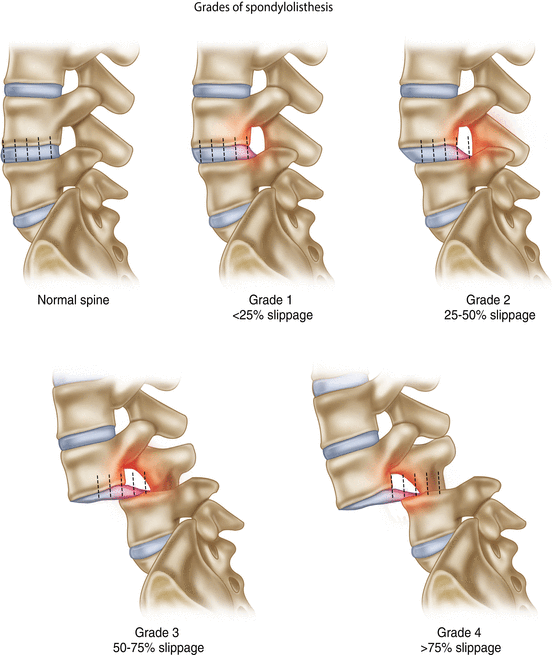(1)
Princeton Spine & Joint Center, Princeton, NJ, USA
Keywords
DegenerativeIsthmicPars interarticularisSpondylolysisFusionSlipSpondylolisthesis is a condition in which one vertebral body slips in relation to another. There are two common types of spondylolisthesis as it relates to lower back pain and leg pain: degenerative spondylolisthesis and isthmic spondylolisthesis. Other causes of spondylolisthesis include congenital, traumatic, pathologic, and postsurgical [1, 2].
In degenerative spondylolisthesis, the bones gradually start to slip in relation to one another. It is most common in people over age 50, more common in women (by a rate of about 3:1), and it most commonly occurs at L4–L5 [3].
In isthmic spondylolisthesis, a stress fracture in the spine at the bilateral pars interarticularis allows the vertebral bodies to slip in relation to one another. The pars interarticularis is critical to maintaining the integrity of the spinal alignment because it connects the facet joint above to the facet joint below. Recall from chapter one that the facet joints prevent anterior-posterior translation of the bones and so loss of the integrity of this unit allows the bones to start to shift. Isthmic spondylolisthesis most commonly occurs at L5–S1 and is more common in males. Fractures of the pars interarticularis tend to occur in young athletes who participate in sports that involve repetitive extension such as gymnastics, ballet, volleyball, rowing, diving, and football [4]. Approximately 8–15 % of asymptomatic adolescents have been reported to have pars interarticularis stress fracture (spondylolysis) [5]. In adolescents with lower back pain, the incidence of spondylolysis has been reported to be as high as 47 % [6]. For fractures of the pars interarticularis to lead to an isthmic spondylolisthesis, it generally (though not always) involves a bilateral fracture.
The degree of spondylolisthesis is graded based on the degree of slippage of the vertebral bodies (Fig. 8.1):


Fig. 8.1
Gra des of spondylolisthesis
Grade 1: <25 % slip
Grade 2: 25–50 % slip
Grade 3: 51–74 % slip
Grade 4: 75–100 % percent slip
It is important to realize that most people with spondylolisthesis have no symptoms. Some reports estimate that as many as 80 % of people with a spondylolisthesis have no pain [7, 8]. However, spondylolisthesis can cause symptoms. When symptomatic, patients generally present with extension-based lower back pain. Sometimes, the pain will radiate into the legs and may be accompanied by radicular symptoms such as numbness, tingling, and/or weakness.
Consider the following patient: Mario is a 68-year-old man who enjoys playing with his grandchildren. He is frustrated because over the last year he has been experiencing increasing lower back pain that is worse with standing and walking and is alleviated with sitting. Mario denies any radiating leg pain or paresthesias in the legs. On physical examination, Mario has lower back pain that is reproduced with trunk extension and bilateral oblique extension. He is neurologically intact on exam.
Most spine specialists would agree at this point in the story that Mario is unlikely to have pain coming from a spondylolisthesis. His pain is certainly consistent with spondylolisthesis pain, but epidemiologically it is much more likely that he has facet joint pain (based on his symptoms) or discogenic pain (based on the known epidemiology of lower back pain). To complicate matters just a little, even if Mario gets an X-ray that reveals a grade I L4–L5 spondylolisthesis, it is still more likely that his pain is coming from his facet joints or disc based on the aforementioned points. Certainly, it could be argued that if Mario has a spondylolisthesis that this mechanical disadvantage may lead to developing other types of lower back pain, but that is not the same thing as having pain directly from the spondylolisthesis.
Stay updated, free articles. Join our Telegram channel

Full access? Get Clinical Tree





